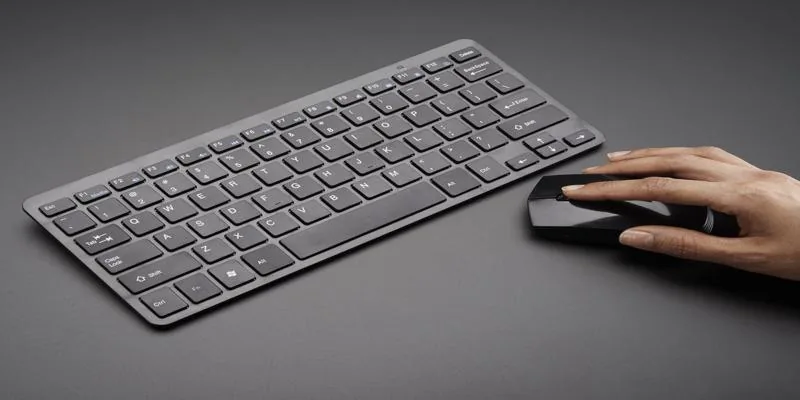Wireless Keyboard Frees Your Space for Seamless Typing
Published: 28 Mar 2025
A wireless keyboard can totally transform how you work or play. No more being stuck to your desk with long cables, just a sleek, smooth connection that lets you move freely. Whether you’re typing away at a project or controlling your media from across the room, the comfort and convenience it offers are hard to beat. Plus, they’re super easy to set up, making them a great choice for anyone looking to upgrade their setup. Let’s get information about wireless keyboard:
Definition
A wireless keyboard is a type of keyboard that connects to a computer or other device without using cables. It communicates through Bluetooth or a small USB receiver, providing more freedom and flexibility. This type of keyboard is popular for its clean setup and ability to work from a distance.
Importance of Wireless Keyboard
A wireless keyboard offers several key benefits that can enhance your typing experience and overall workspace:
- Clutter-Free Workspace: Without cables, your desk remains neat and organized.
- Greater Flexibility: You can type from a distance or move around freely while using your device.
- Portability: Easy to carry, making it ideal for use on the go or with multiple devices.
- Comfort: No wires to get tangled in, allowing for a more relaxed and comfortable setup.
- Aesthetics: Adds a modern, clean look to your workstation or living room setup.

Types of Wireless Keyboards
There are several types of wireless keyboards, each designed for different needs and preferences. Whether you’re using it for work, gaming, or casual use, here’s a breakdown of the most common types:
- Bluetooth Keyboards: Connects directly to devices without the need for a USB receiver.
- RF (Radio Frequency) Keyboards: Uses a USB receiver to connect to the device.
- Multi-Device Keyboards: Allows you to switch between multiple devices, like a PC, tablet, or phone.
- Ergonomic Keyboards: Designed to reduce strain with a split or curved layout for comfort.
- Compact Keyboards: Smaller, lightweight designs for portability and space-saving.
Applications of Wireless Keyboards
Wireless keyboards are versatile tools that can be used in various settings, offering convenience and flexibility. They are especially useful in environments where mobility and a clean setup are important.
- Home Offices: Reduces desk clutter, allowing you to work comfortably without wires.
- Presentations: Use from a distance to control slides or media without being tied to a desk.
- TV & Media Control: Pair with smart TVs or media players for easy navigation and typing.
- Gaming: Offers freedom to play from a distance with less clutter.
- Mobile Devices: Connects to tablets or phones, providing a better typing experience than touchscreens.
Pros and Cons of Wireless Keyboards
Wireless keyboards offer both great benefits and a few downsides to consider. Here’s a quick look at what you should know:
| Advantages of Wireless Keyboard |
|---|
|
| Disadvantages of Wireless Keyboard |
|---|
|
A wireless keyboard is a keyboard that doesn’t use cables to connect to your device. It uses Bluetooth or a USB receiver to send signals. This makes your setup cleaner and more flexible.
Wireless keyboards use Bluetooth or radio frequency (RF) to send signals to your device. Bluetooth connects directly, while RF uses a small USB receiver. Both methods help eliminate the need for cables.
Most wireless keyboards are compatible with Windows, Mac, and even tablets or smartphones. Just check if your device supports Bluetooth or has a USB port for the receiver. You can easily find this information on the keyboard’s packaging or product page.
For Bluetooth keyboards, turn on Bluetooth on your device, then select the keyboard from the list of available devices. For RF keyboards, plug the USB receiver into your device, and it should connect automatically. Both methods are simple and quick.
The lifespan of a wireless keyboard depends on usage and battery type. Most keyboards can last for several years, but you may need to replace the batteries after a few months or recharge it if it has a built-in battery. Proper care can help extend its life.
Yes, you can use a wireless keyboard for gaming, but make sure to choose one with a fast response time. Some wireless keyboards may have slight input lag, which might be noticeable in fast-paced games. Look for gaming-specific models to avoid this.
Wireless keyboards can be a bit more expensive than wired ones due to the technology involved. However, prices have become more affordable over time, and the convenience of a wireless connection often justifies the extra cost. It’s a good investment for a cleaner, more flexible setup.
Yes, most wireless keyboards need batteries to work. Some use disposable batteries, while others have rechargeable ones. You can choose based on your preference for convenience or battery longevity.
If your wireless keyboard is rechargeable, it’s best to check the model’s instructions. Some allow you to use it while charging, while others may require you to unplug it for use. Always refer to the manufacturer’s guidelines.
First, check if the batteries need replacing or if the keyboard is charged. Then, make sure the Bluetooth or USB receiver is properly connected. If it still doesn’t work, try restarting your device or re-pairing the keyboard.
Conclusion
So guys, in this article, we’ve covered wireless keyboards in detail. After looking at the features and benefits, I suggest considering a wireless keyboard to boost your productivity and comfort. You’ll love the freedom it gives you to work or relax without being tethered to your desk. Don’t wait, upgrade your setup today and experience the convenience for yourself!

- Be Respectful
- Stay Relevant
- Stay Positive
- True Feedback
- Encourage Discussion
- Avoid Spamming
- No Fake News
- Don't Copy-Paste
- No Personal Attacks

- Be Respectful
- Stay Relevant
- Stay Positive
- True Feedback
- Encourage Discussion
- Avoid Spamming
- No Fake News
- Don't Copy-Paste
- No Personal Attacks
